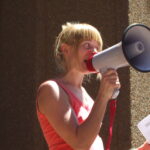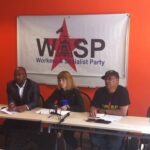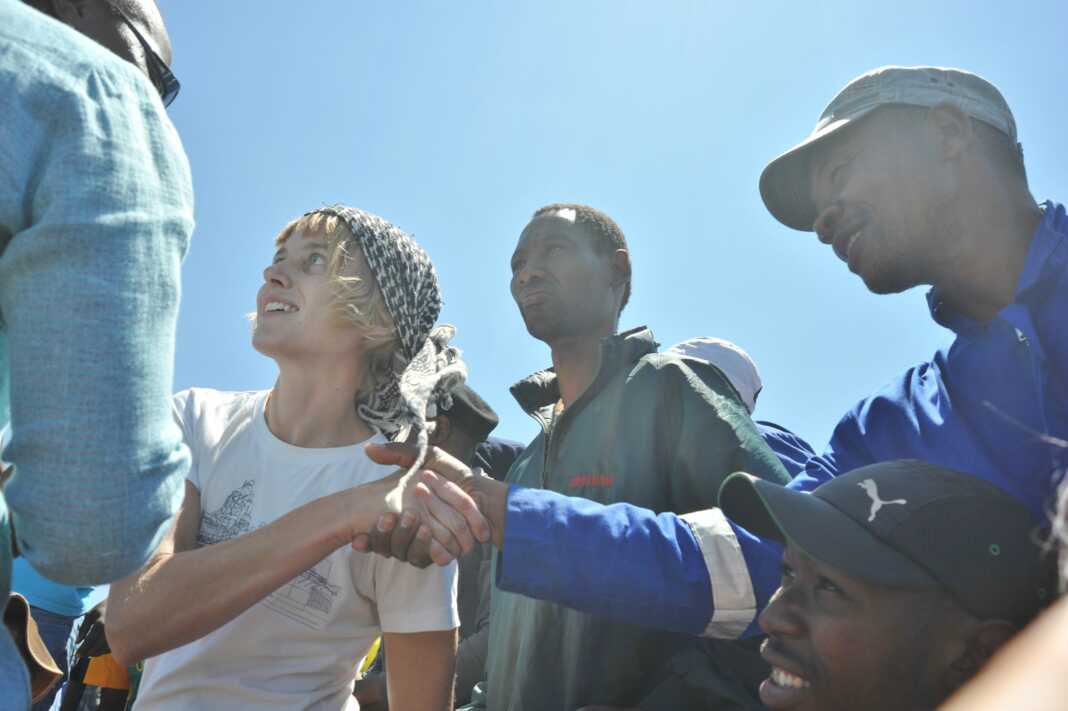After nearly twelve years in South Africa, Liv Shange, Executive Committee member of the Workers and Socialist Party, is returning to her native Sweden on 27 July 2015. Reluctantly, in the face of the insurmountable obstacles the ANC government had placed in the way of her efforts to settle in SA permanently, she has had no option but to leave to fight for her right to permanent residence from outside the country. This is not so much a defeat as a setback – a decision forced upon her and WASP for political reasons.
She leaves with great regret but also pride. She has invested so many years of what became her most important formative years politically in SA, sunk so many personal roots, and brought up her children here. But she also established, in the closing chapter of her life in SA, a political profile and reputation that is unparalleled for any white female socialist revolutionary in the post-apartheid era.
Over the past decade in SA, it was particularly the last three years – the most tumultuous years in the country’s post-apartheid history – that have been the most rewarding. From the relative obscurity of being a socialist councillor in a small northern Swedish town she came to adorn the front and editorial pages of SA’s major newspapers, appeared on numerous radio interviews including African language ones, became the subject of investigative programme Carte Blanche, and was even given ‘celebrity’ status in a women’s magazine.
Fittingly, she has had many bouquets bestowed upon her and, unsurprisingly a few brickbats. Two in particular stand out: her designation as one of SA’s foremost socialist activists by Moeletsi Mbeki, brother of the former SA president Thabo Mbeki, and her denunciation by ANC secretary general Gwede Mantashe who alleged she had incited the mineworkers to strike thus causing “chaos” on the mines. This insult was directed at Liv but, like a ricocheting bullet hit Mantashe himself. His portrayal of the mineworkers as incapable of understanding their slavery and acting only because a white Swedish woman told them too, betrayed the contempt he held the mineworkers in. Liv will probably treasure Mantashe’s loathing and carry it with pride.
It was the hysterical attack on Liv by Mantashe – who must be drawing satisfaction over Liv’s forced departure – that led directly to the government’s humiliating climb down after its attempt to prevent her from returning to SA from a visit to her family in Sweden. The Committee for a Workers International’s (CWI) magnificent international campaign that unleashed a deluge of protest letters and demonstrations at SA embassies in countries worldwide forced the Home Affairs minister to take the unprecedented step of issuing a directive to all ports of entry that Liv be allowed to re-enter the country without let or hindrance.
Arrival in SA
 The journey of Liv’s still young life confirms the adage popular amongst socialists, that the personal is political. She fell in love with her South African partner at the World Congress of the CWI in 2002, delegates respectively of the Swedish and SA sections.
The journey of Liv’s still young life confirms the adage popular amongst socialists, that the personal is political. She fell in love with her South African partner at the World Congress of the CWI in 2002, delegates respectively of the Swedish and SA sections.
So it is not SA that provided the foundations for Liv’s ideological outlook or political convictions. Her native Sweden takes the credit for that. She arrived in SA having the benefit of her political training in the Rattvisepartiet Socialisterna (Socialist Justice Party) – Swedish section of the CWI and one of its co-founders and most experienced affiliates – for whom she had been a full-time cadre.
Using her political experience and exceptional talents, she made an immediate difference to the DSM’s work. Enrolled at the University of KZN to study BA Zulu & Economic History, from where she graduated summa cum laude and fluent in IsiZulu, she set about, with the support of her partner, developing the DSM’s student work.
Liv assisted in the establishment of the Socialist Student Movement (predecessors of the Socialist Youth Movement) at the University of KwaZulu Natal where they would almost certainly have won a seat in the Student Representative Council if they had not scandalously been barred from standing. Under Liv’s leadership the SSM was to lead the first demonstration through the streets of Durban for free education under the ANC’s neo-liberal education policy. All of this was achieved despite the political hostility that SSM and Liv personally attracted, being subjected to racist and sexist abuse by leaders of the Progressive Youth Alliance of the SA Student Congress, the ANC Youth League and the Young Communist League.
Having earned her spurs in Durban she was deployed to DSM’s Johannesburg head office as our first political full-timer. One of the many talents she brought to the editorial board of the DSM’s paper Izwi Labasebenzi (now the organ of WASP) was the lay-out of the paper – a skill entirely self-taught – and translating articles into isiZulu, giving the paper a much more politically effective profile.
Preparing for the earthquake
 The entire period of her life in SA before the Marikana earthquake had prepared her for the intervention she made so effectively amongst mineworkers with fellow WASP leader Mametlwe Sebei. Alone on the left, the Democratic Socialist Movement (DSM) had foreseen that it would be in the mining industry that the first major rebellion against the Cosatu leadership was likely to break out. The ideological and political degeneration of the Cosatu leadership was expressed most sharply in the National Union of Mineworkers (NUM). It had evolved into a yellow union, the leadership’s class collaboration with the bosses sinking to the level where NUM leaders could not meet with their own members without carrying firearms.
The entire period of her life in SA before the Marikana earthquake had prepared her for the intervention she made so effectively amongst mineworkers with fellow WASP leader Mametlwe Sebei. Alone on the left, the Democratic Socialist Movement (DSM) had foreseen that it would be in the mining industry that the first major rebellion against the Cosatu leadership was likely to break out. The ideological and political degeneration of the Cosatu leadership was expressed most sharply in the National Union of Mineworkers (NUM). It had evolved into a yellow union, the leadership’s class collaboration with the bosses sinking to the level where NUM leaders could not meet with their own members without carrying firearms.
From the shocking accounts of the NUM’s role we drew the conclusion that the chain of illusions binding the workers to Cosatu, the most important partner in the Tripartite Alliance, was likely to break at its strongest link – the NUM, at the time the biggest, richest and politically most influential of the federation’s affiliates, led moreover by SA Communist Party central committee members.
Three years before Marikana, with the scantiest of resources, the DSM had responded enthusiastically to the appeal by the Murray & Roberts workers for assistance in the struggle for the reinstatement of 4000 workers dismissed for ‘illegally’ continuing a strike that the NUM leaders had betrayed.
Marikana
To the attempt to drown their strike in blood at the Marikana massacre, the mineworkers responded by turning what began as a wage strike into a political uprising. Liv and Mametlwe secured support for the DSM’s call for a Rustenburg-wide general strike, brought the independent strike committees from all mines together into the All-Rustenburg Coordinating Strike Committee, and then campaigned to have the surrounding community drawn into a Rustenburg Workers and Community Forum.
The strike ignited a countrywide mine workers movement beyond the North West province, drawing in Gauteng, Mpumalanga, Limpopo and the Northern Cape leading to the establishment of a National Strike Committee. It electrified the entire working class including, famously, the most downtrodden – the Western Cape farm workers – who just a few months late copied the methods of struggle used by the mineworkers.
The Marikana massacre was the most important political event in post-apartheid history with comrades Liv and Mametlwe in the forefront of the movement that it triggered, translating the workers’ political conclusions into action. Liv was at the meeting on 15 December 2012 in Limpopo when the DSM and representatives of six mineworkers’ strike committees agreed to form the Workers and Socialist Party. WASP was launched on Sharpeville Day, 21 March 2013 – the first consciously socialist party formed directly out of workers struggle and registered to contest elections in the post-apartheid period.
Both the decisions of Numsa’s historic December 2013 resolutions to form a workers party, a united front and a movement for socialism as well as the birth of the EFF had their basis in the objective political situation. But it is no exaggeration to say that WASP’s presence on the political plane and its bold socialist stance provided an ideological and political point of reference for the Numsa delegates and compelled the EFF to dress its populist policies in anti-capitalist clothing.
The struggle continues
Political developments in SA are headed in the direction of a mass workers party. That is the inescapable conclusion from developments firstly and foremostly in Numsa, as well as the deepening divisions in the ANC, the implosion of Cosatu, the insistent demand from within the SACP for it to stand independently and the attempted reinvention of the Democratic Alliance.
WASP will continue to contribute to the unification of the struggles of the working class in its three main theatres – service delivery protests, workplace struggles and the battles of the youth – with the aim of bringing them together in a mass workers party on a socialist programme.
In the meantime, as a socialist and internationalist, Liv will re-enter the struggle for socialism on the same front from which she had taken indefinite leave more than a decade ago at a time when as events in Greece show, the class struggle is poised to reach new heights in Europe.

